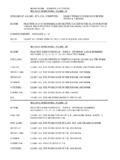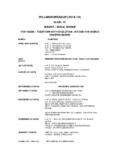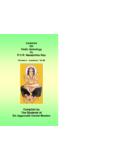Transcription of Sanskrit Made Simple- a study of asana names - …
1 Sanskrit made simple - a study of asana names by Marie Roulleau & Gwynneth Powell* Can't quite tell "Urdhva Mukha Paschimottanasana" apart from "Prasarita Padottanasana"? Not sure what to do when the teacher calls for "Karnapidasana"? Not clearly visualising "Utthita Hasta Padangusthasana"? Fear not, help is on the Two things will make identification of asanas (poses) easier. First you must know that those long Sanskrit words are in fact like strings of pearls. For example, Urdhva Mukha Paschimottanasana has 5 words in it; Urdhva (upward); Mukha (face); Paschima (West or backside of the body); Uttana (intense); asana (pose). Learning to identify the smaller words within the long name makes it easier not only to recognize but also to start to pronounce. The second thing is that in English (as well as other languages) we use words that are distant cousins to Sanskrit . Languages The languages of the western world have developed from one original tongue.
2 No written record exists of this mother tongue, but strong similarities between words in different western languages, called Indo-European languages, point to a common origin. The oldest languages of the Indo-European family are Sanskrit (2000 ), Greek (800 ) and Latin (500 ) French is a direct descendant of Latin, and about half of English words come from French. The Anglo-Saxon side of English, related to German, is also part of the big Indo-European family. One day in yoga class I understood a very obvious link. The teacher said that janu meant knee. I recognised this immediately because in my mother tongue, French, the word for knee is genou, and is similarly pronounced like janu. In the Glossary of Light on Yoga I saw another strong connection. Mrta is Sanskrit for dead or corpse. In French, mort means death or dead and then goes on into English to show up again in mortuary (a place for the dead). The names of Asanas The names of asanas are most commonly from four categories: anatomy; animals; sages and deities; and objects.
3 Additionally, names of poses are further broken down into numbers and characteristics of the pose. As we get acquainted with some of these basic translations within the asana , then the longer names of asanas start to become decipherable. Anatomy: 1. Pada: foot/ leg (pied in French means foot, while pedestrian in English denotes someone on foot) 2. Hasta: hand 3. Anguli: fingers 4. Anghusta: big toe 5. Janu: knee 6. Sirsa: head 7. Mukha: face 8. Karna: ear 9. Jattara: stomach 10. Anga: limb 11. Bhuja: arm 12. Sarvanga: whole body 13. Sava: corpse 14. Prana: breath/ lifeforce 15. Paschima: west direction (back side of body) 16. Purva: east direction (front side of body) Animals: 1. Svana: dog 2. Bheka: frog 3. Baka: crow 4. Ustra: camel 5. Go: cow 6. bhujanga: snake/ serpent 7. kapota: pidgeon/ dove 8. kurma: turtle 9. matsya: fish 10. shalabha: locust/ grasshopper Sages and Deities: ** 1. Bharadva: a sage; also the father of famous archer, Drona, who trained the cousins who would later became rivals and fight the famous war that the Bhagavad-Gita was written about.
4 2. Garuda: was the king of the eagles; Garuda once provided transportation and carried Lord Vishnu to the aid of devotee, Gajendra who was in a life threatening situation. 3. Marichi: son of Brahma and grandfather of Surya the sun god. 4. Matsyendra: Lord of the Fishes; Shiva discovered a fish, who had completely learned his teachings of yoga. Shiva gave him divine form to then spread the knowledge of yoga. 5. Surya: Sun god 6. Virabhadra: the great warrior who sprang to Shiva s aid to seek revenge on his father-in-law. 7. Nataraja: one of the names of Shiva, the lord of the dance. 8. Hanuman: chief of the monkey army; one of Rama s greatest devotees who came to his aid. Hanuman made huge leaps across the sea- first to find Sita and then to save Rama s brother. Objects: 1. Parigha: gate latch 2. Hala: plough 3. Vrksa: tree 4. Tola: scales 5. Tada: mountain 6. Setu: bridge 7. Nava: boat 8. Mudra: seal 9. Dhanu: bow 10. Danda: rod/ staff 11. Chandra: moon 12.
5 Vira: hero 14. asana : pose/ posture Numbers: 1. Eka: one 2. Dwi: two, both (dwa in Polish, pronounced dva) 3. Tri: three (trios in French) 4. Chatur: four (cztery in Polish, pronounced ch-terry) 5. Ashta: eight Characteristics: 1. Adho: downward 2. Urdva: raised/ upward 3. Utthita: extended, stretched. 4. Parivrtta: revolved 5. Baddha: tied/ bound 6. Supta: reclining/ sleeping 7: Uttana: intense stretch 8. Sthiti: stability 9. Upavistha: seated 10. Prasarita: spread out 11. Ardha: half 12. Salamba: with support 13. Nirlamba: without support 14. Kona: angle 15. Pida: pressure QUIZ - Name that Pose: a. three angle pose b. reclining bound angle pose c. the pose where you take your head to one knee; or where you stretch the head of the other knee d. the pose where you hold the body stiff like a rod, with only your four limbs touching the floor (downward push-up position) e. downward face dog pose f. the pose were you put pressure on the ears g.
6 The pose where the whole body is supported h. headstand or head balance i. one leg out to the side in supported shoulderstand j. spreading the feet intensely pose Answers: a. tri-kona- asana = Trikonasana b. supta-baddha-kona-anana = Supta Baddha Konasana c. Janu-sirsa- asana = Janu Sirsasana (also means head of the knee stretches back) d. chatur-anga-danda- asana = Chaturanga Dandasana e. adho-mukha-svana- asana = Adho Mukha Svanasana f. karna-pida- asana = Karnapidasana g. samamba-sarvanga- asana = Salamba Sarvangasana h. head-pose = sirsa asana = Sirsasana i. parsva-eka-pada-sarvangasana = Parsvaika Pada Sarvangasana j. Prasarita-pada-uttana- asana = Prasarita Paddottanasana * With the assistance of Paul Sobejko who compiled a comprehensive list of Sanskrit yoga terms relating to asana from Light on Yoga ( Iyengar, 1966) and Yoga for Children (Swati and Rajiv Chanchani, 1995). ** There are some great stories of the sages and deities in Light on Yoga.
7 For example, to find out more about the sage Virabhadra, look up the pose Virabhadrasana in the index, the history of that sage will be within the first variation of that pose Virabhadrasana I (and so forth for Bharadva, Hanuman, etc). For even more research on Indian sages and deities, find a translation of The Mahabharata (one of the great epics, in which the Bhagavad-Gita is contained).







